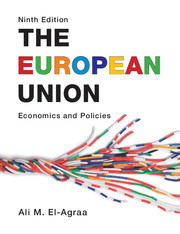Book contents
- Frontmatter
- Contents
- Figures
- Tables
- Boxes
- Contributors
- Preface
- A reader’s guide
- Abbreviations
- 1 General introduction
- Part I EU history, institutions and legal dimension
- Part II EU market integration
- Part III EU monetary integration
- Part IV The single European market
- Part V EU budget and structural policies
- Part VI EU external relations
- Part VII The future of the EU
- Bibliography
- Author Index
- Index
- References
1 - General introduction
the EU within the context of regional integration worldwide
- Frontmatter
- Contents
- Figures
- Tables
- Boxes
- Contributors
- Preface
- A reader’s guide
- Abbreviations
- 1 General introduction
- Part I EU history, institutions and legal dimension
- Part II EU market integration
- Part III EU monetary integration
- Part IV The single European market
- Part V EU budget and structural policies
- Part VI EU external relations
- Part VII The future of the EU
- Bibliography
- Author Index
- Index
- References
Summary
The European Union (EU) is the most prominent scheme of international economic integration (IEI). The first aim of this chapter is to provide a precise definition of IEI, since what it means to those specializing in trade theory is very different to what one would expect on purely linguistic grounds. IEI creates ‘clubs’ between some nations, which discriminate against non-members, in contrast to multilateralism, which extends agreed ‘arrangements’ to all nations. The World Trade Organization (WTO), which regulates trade, is based on the principle of non-discrimination, so the second aim of the chapter is to examine how IEI fits within the WTO framework. IEI can take several forms, and the third aim is to describe the various schemes that have actually been adopted worldwide and to set the EU within this broader context, substantiating the statement made in the opening sentence about the EU. The fourth aim is to show why most countries seek IEI – that is, to consider what economic or other benefits become possible as a consequence of IEI.
What is economic integration?
IEI is one aspect of ‘international economics’, which has been growing in importance since the middle of the twentieth century. The term itself has quite a short history; indeed, Machlup (1977) was unable to find a single instance of its use prior to 1942. Since then the term has been used at various times to refer to practically any area of international economic relations. By 1950, however, the term had been given a specific definition by international trade specialists to denote a state of affairs or a process which involves the amalgamation of separate economies into larger free trading regions. It is in this more limited sense that the term is used today. However, one should hasten to add that recently the term has been used to mean simply increasing economic interdependence between nations, now glamorized as globalization.
- Type
- Chapter
- Information
- The European UnionEconomics and Policies, pp. 1 - 16Publisher: Cambridge University PressPrint publication year: 2011



